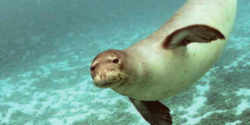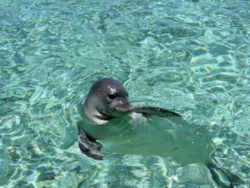
Hawaii Symbols
Hawaii State Mammal
Hawaiian monk seal

(Monachus schauinslandi)
Adopted in 2008.
Hawaii Lieutenant Governor Duke Aiona signed a bill into law giving the endangered and much-beloved Hawaiian monk seal,(Monachus schauinslandi,) the official designation for the State of Hawaii. Wildlife experts- who have long considered the seal one of the world's most-endangered species- hope the move will raise international awareness about the native Hawaii mammal's plight.
Hawaii State Mammal: Hawaiian monk seal

Mature Hawaiian monk seals feature a gray pelage, or coat, which turns brown with weathering. Young Hawaiian monk seals are silver with creamy white stomachs, chests, and throats. Pups are black and woolly with fuzzy short hair. Newborn pups are clad in a black natal fur. A number of Hawaiian monk seals sport scars from attempted shark attacks or injuries from fishing gear. Females are often scarred by encounters with males, which can be particularly brutal during the mating season. Adult males are 300 to 400 pounds in weight and at 7 feet in length while adult females tend to be 400 to 600 pounds and at 8 feet in length. Pups average at 30 to 40 pounds at birth and at 40 inches in length. Life expectancies are from 25 to 30 years.
Characteristics of the Hawaiian monk seal
Geographic Range
These seals occur on small, uninhabited northwestern Hawaiian islands. Principle sites are on Nihoa and Necker islands, French Frigate Shoals, Pearl and Hermes Reef, Kure Atoll, and Laysan, Lisianski, and Midway islands.
Biogeographic Regions:
ceanic islands (native ); pacific ocean (native ).
Habitat
Hawaiian monk seals frequent reefs (for feeding), beaches (for basking and delivering their young), and coves. They spend a great deal of time wallowing in damp sand at the water's edge, presumably to avoid overheating.
These animals are found in the following types of habitat:
tropical ; terrestrial ; saltwater or marine.
Reproduction
Gestation period
335 days (average)
Age at sexual or reproductive maturity (female)
1825 days (average)
Females mature at about five years of age. Only 60- 70% of adult females give birth in a given year. Mating takes place underwater. Most births take
place from March-June after a gestation of 11 months (including a period of delayed implantation). Females give birth and suckle their young on sandy
beaches with or without shade, and sometimes on the rocky shores of Necker Island. Usually one pup is born per litter. Pups weigh 36 lbs at birth and
are 1m long. They have soft, black hair that is moulted after 3-5 weeks into a coat that is silver-blue dorsally and silvery-white ventrally. Pups
are weaned at about six weeks. Males outnumber females by 3:1, so when a group of males spot a female in estrus they sometimes mob her, inflicting
serious or mortal wounds in their eagerness to mate.
Behavior
Hawaiian monk seals do not migrate, although certain individuals may disperse over long distances. These animals are mostly solitary, although females
will sometimes foster another female's youngster. Approaches by large dominant males elicit submissive behavior from other seals. Females with pups
are extremely sensitive to disturbances; they will threaten, or if necessary, attack invaders. These aggressive interactions among females often lead
to pups switching mothers. Females fast for 2-3 months after weaning their young.
These monk seals are primarily nocturnal, resting during daytime heat and diving for food at night.
Food Habits
Monk seals feed mainly on benthic and reef-dwelling fishes and invertebrates, including flatfish, scorpenids, eels, octopuses, and spiny lobsters. They forage in depths from 10m-40m along the slopes of coral reefs.
Hawaii Senate Bill: Twenty-Fourth Legislature, 2008
THE SENATE
TWENTY-FOURTH LEGISLATURE, 2008
STATE OF HAWAII
2464 S.6. NO CH.-DD. .1l
A BILL FOR AN ACT
RELATING TO THE STATE MAMMAL.
BE IT ENACTED BY THE LEGISLATURE OF THE STATE OF HAWAII:
SECTION 1. The Hawaiian monk seal (Monachus schauinslandi) is the only marine mammal whose entire species range lies within the United States. It is
one of only two endemic mammals found in Hawaii.
On November 23, 1976, it was listed as an endangered
species pursuant to the Endangered Species Act and it remains listed as endangered today. The population of the Hawaiian monk seal has been in a 20-year
constant decline and today there are only approximately 1,200 remaining. The majority of this population is in the Northwestern Hawaiian Islands, while
there are an estimated 80 monk seals living in the main Hawaiian Islands.
In 1979, the legislature designated the humpback whale as the official marine mama1 of the State. Part of the purpose for doing so was to increase
awareness about the humpback whale, which was on the brink of extinction in the 60s. As a result of an increase in awareness regarding the humpback
whale, its numbers have markedly increased. A purpose in designating the Hawaiian monk seal as the official state mammal is to raise awareness of it
as an endangered species with the hope that this awareness will, like the humpback whale, result in increased protection and its repopulation.
The purpose of this Act is to recognize the importance and uniqueness of the Hawaiian monk seal to the Hawaiian Islands by establishing and designating
the Hawaiian monk seal as the official state mammal.
SECTION 2. Chapter 5, Hawaii Revised Statutes, is amended by adding a new section to be appropriately designated and to read as follows:
"15- State mammal. The Hawaiian monk seal (Monachus schauinslandi) is established and designated as the official mammal of the State."
SECTION 3. New statutory material is underscored.
SECTION 4. This Act shall take effect on July 1, 2008.
S.B. NO. 2464
H.D. 1
C.D. 1
Report Title:
Hawaiian Monk Seal; State Mammal
Description:
Designates the Hawaiian monk seal as the state mammal. (CD1)
Hawaii Law
The law designating the Hawaiian monk seal as the official Hawaii state mammal is found in the Hawai'i Revised Statutes, Volume 1, Chapter 5, Section 5-12.5
Volume 1.
CHAPTER 5. EMBLEMS AND SYMBOLS.
SECTION -5-12.5
[§5-12.5] State mammal. The Hawaiian monk seal (Monachus schauinslandi) is established and designated as the official mammal of the State.
[L 2008, c 72, §2]
Taxonomic Hierarchy: Hawaiian Monk Seal
Kingdom: Animalia
Phylum: Chordata
Class: Mammalia
Order: Carnivora
Family: Phocidae
Genus: Neomonachus
Species: N. schauinslandi







